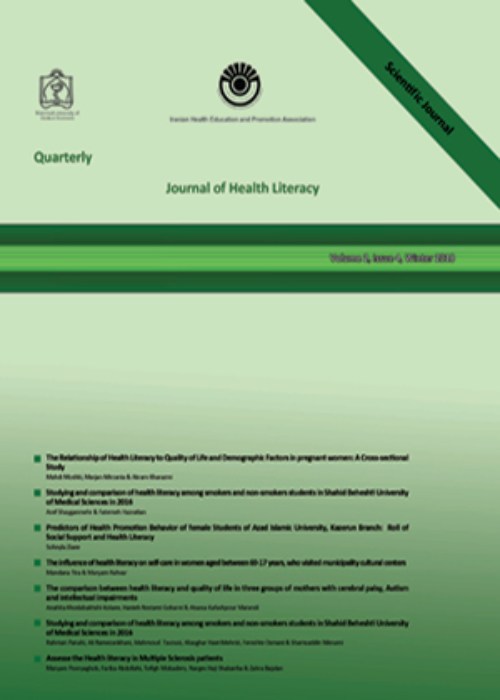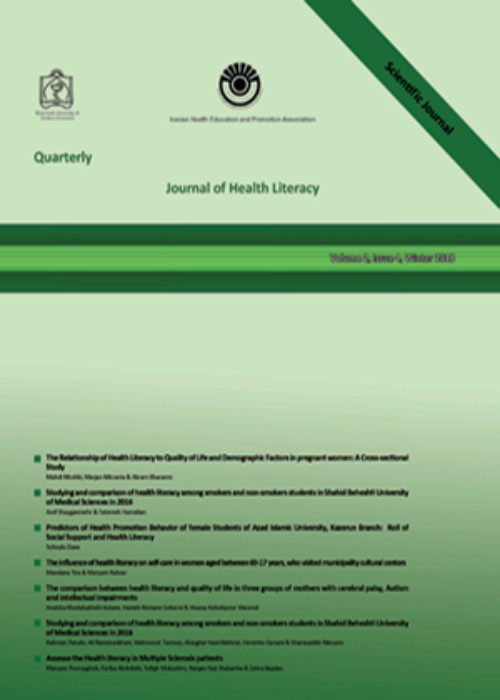فهرست مطالب

Journal of Health Literacy
Volume:8 Issue: 1, Spring 2023
- تاریخ انتشار: 1402/03/30
- تعداد عناوین: 8
-
-
Pages 9-18Background and ObjectivesThe concept of health literacy shaping attitudes and behaviours is critical in preventing and controlling person-to-person transmission in the spread of infectious diseases. Health literacy is a determinant of health; it impacts the effective use of health behaviour by empowering individuals and communities to prevent epidemics like Coronavirus and Monkeypox. The study aims to assess the association between health-protective behavior and health literacy for preventing the spread of the Coronavirus during the pandemic in adolescents of Rawalpindi, Pakistan.Materials and MethodsA cross-sectional descriptive study was conducted in public and private schools of Rawalpindi, 387 middle and high school students. Multiple linear regression was used to find the association between the main explanatory variable, health literacy and the outcome variables, health knowledge and health behaviour. The study was conducted in ten different sessions, each requiring one hour from 1st August to 31st October 2021, the self-administered questionnaire was used as a data collection tool, and a total of 387 participants took part in the study. Data were entered and analysed using SPSS Version 27.ResultsMultiple linear regression analyses showed a significant association between health literacy and health knowledge ( β ̂ = 0.04, 95% CI = 0.005–0.069, p=0.023), and between health literacy and health behaviour (β ̂= 0.07, 95% CI = 0.048–0.099, p<0.001).ConclusionHealth literacy is significantly associated with increased hand hygiene knowledge and behaviour. Government should prioritise health literacy policy and practice and make it more sustainable, effective, and integral using the multi-level targeted approach for the national educational sector.Keywords: Adolescents, behaviour, COVID-19, Education, Hand Hygiene, health promotion
-
Pages 19-27Background and ObjectiveParents' oral health literacy may be a reliable predictor of children's oral health. Therefore, the present study was conducted to develop and validate a questionnaire to assess parents' oral health literacy about their children's oral health.Materials and MethodsThis study was conducted from April 2020 until October 2020. Questionnaire items were developed by evaluating content validity based on expert opinions, content validity ratio, and content validity index, and cognitive interview. Random sampling was used to recruit a total of 500 patients from referral hospitals in the city of Kerman. Based on factor analysis, construct validity included exploratory factor analysis via SPSS software version 22, and confirmatory factor analysis via Mplus software version 7.4. The invariance of the model evaluation and the evaluation of the reliability of the questionnaire were assessed based on Cronbach's alpha coefficient.ResultsFirst, 71 items were chosen for evaluation, and then 19 items were promoted to the next stage, based on the content validity coefficients. The results of the exploratory factor analysis led to the extraction of a three-factor model of Parent's Oral Health Literacy Measure (POHeLM) about children's oral health. These three factors explained 56% of the total variance of the questionnaire altogether. These three factors include the accessibility domain (two items), the utilization domain (eleven items), and the communication domain (six items). Model fit indices based on confirmatory factor analysis confirmed the proper fit of the three-factor model. Also, in measuring the factor invariance, the model's validity in both male and female was authenticated. The Cronbach’s alpha coefficient was calculated as 0.81.ConclusionThis study shows that the POHeLM questionnaire possesses appropriate validity and reliability by 19 questions and 3 subclass.Keywords: Oral Health, Health Literacy, Questionnaire design, Validation
-
Pages 28-41Background and ObjectiveOur objective was to determine the frequency of inadequate functional health literacy (FHL) among adult Kurd population, and infer the contribution index of sociodemographic factors for FHL across gender.Materials and MethodsIn this cross-sectional study, multistage cluster sampling was employed to recruit 1000 people older than 18 years from 38 urban and 14 rural healthcare centers in Sanandaj, Iran. Data on FHL was collected from May to July 2019, through face-to-face interviews by using the validated Persian version of the Test of functional health literacy in adults (TOFHLA). The concentration index method was used to measure inequality in FHL.ResultsOverall, 869 respondents (response rate: 86.9%) with a mean age of 33.68 (±13.0) completed the TOFHLA questionnaire. The average TOFHLA score was 51.9, which was 52.2 (±0.46) among males and 50.7 (±0.40) among females, p<0.001. Among females, the place of residence, monthly income, age, education level, and being head of the household contributed to 43%, 32%, 13%, 11.5%, and 11% of FHL inequality, respectively. While, among males, the place of residence (45.2%), household size (15.1%), and monthly income (13.5%) contributed most to inequality in FHL.ConclusionFHL has disparities by gender and location. Males and rural people are at particular risk for poor FHL. For ease and better resolution of poor FHL, each population, gender, and area type should be considered as a stand-alone, which may help in identifying tailored interventions for males and females with low levels of FHL.Keywords: Health Literacy, health disparity, Inequality, Gender
-
Pages 42-51Background and ObjectiveIt is important to use a standardized tool that has standard questions with the power to explain people's abilities and distinguish between them. This research was conducted with the aim of designing, validating and standardizing the oral health literacy questionnaire among Iranian medical students.Materials and MethodsThis is a cross-sectional study, which was done in the Ahvaz Jundishapur University of Medical Sciences in 2021. Pre-validation and post-validation were used for validation. The quality of questions was examined by difficulty and discrimination indices. The pre-validation population included 50 students and 10 experts for validation. Post-validation population includes 354 medical students. SPSS software ver26 and Amos software ver24 were used.ResultsThe tool is valid based on face validity, content validity and construct validity. Totally Cronbach`s alpha was 0.768. Explanatory factor analysis showed a model with four factors named “preventive measures”, “dental care”, “oral diseases”, and “care and visit dentist” which can explain 57.07 percentages of oral health literacy variances. Pearson correlation coefficient showed significant correlation between factors. Confirmatory factor analysis showed model is fit and the model fit indices were as follows: IFI= 0.697, CFI= 0.702, NFI= 0.717, AGFI= 0.767, GFI= 0.824, and RMSEA=0.07.Based on DIF and DI indices, this tool can show the students with correct answers and differentiate the students with high scores from low performing ones.ConclusionThe current research tool has paid attention to different aspects of oral health and preventive and care measures. The approved tools include 3 factors and 22 questions.Keywords: Dental health survey, Health Behavior, Health Literacy, Holistic health, Oral Health
-
Pages 52-61Background and ObjectivesCovid-19 pandemic has led to a wide range of psychological disorders, including anxiety. Inadequate health literacy is associated with poor mental health. People with higher health literacy are more likely involve preventive behaviors. This study aimed to determine the correlation between health literacy and anxiety caused by covid-19 in adults.Materials and MethodsThis cross-sectional study was conducted on adults over 18 years old in Jahorm city, Fars province, Iran, in 2021. A total of 197 participants were selected using multistage cluster random sampling. Demographic information and two standard questionnaires included Corona Disease Anxiety Scale (CDAS) and Health Literacy for Iranian Adults (HELIA) was used to collect data. The data was analyzed by SPSS 17.0 based descriptive statistics, independent t-tests, and Pearson's correlationResultsThe mean raw score of total health literacy was 131.62±0.33, and the mean score converted to 100 was 74.72±15.46, which indicates that the health literacy of participating in the study was favorable. The results of Pearson's correlation coefficient showed that with the promotion of health literacy, the anxiety caused by covid-19 (r=-0.351, p<0.001), the psychological (r=-0.339, p<0.001) and physical (r=-0.323, p<0.001) dimensions, significantly decreased and improved. There was also a significant correlation between the reading (r= -0.200, p=0.005), understanding (r=-0.202, p=0.004), appraisal (r=-0.275, p<0.001), and decision (r=-0.383, p<0.001) dimensions with anxiety that caused by covid-19.ConclusionThe community's health literacy level can be an important factor in reducing anxiety caused by health problems such as the Covid-19 pandemic.Keywords: Health Literacy, COVID-19, Anxiety
-
Pages 62-73Background and Objective
Assessing the level of AIDS literacy and recognizing the predictors of health literacy in this field is essential for the prevention and control of this disease in society .The aim of this research was to mesure level of HIV/AIDS health literacy among young monitored who worked in health centers of Tehran University of Medical Sciences.
Materials & MethodsThis is a cross-sectional descriptive research conducted on 424 young people in the south of Tehran in 2021. Stratified random sampling was used. Informed consent, voluntary participation, and 18-29 age ranges were the criteria to enter the study. A standard HIV/AIDS health literacy instrument, whose reliability and validity had been established, were used to assess health literacy. Data was descriptively and analytically analyzed through SPSS16 based on the independent t-test and one-way ANOVA.
ResultsThe average HIV/AIDS health literacy rate among the youth was 11.52. Almost 28% of participantes were adequately literate and 72% had inadequate literate. The relationship among gender (p=0.035), marital status (p=0.001), and health literacy was significant. These people with the following characteristics were more HIV/AIDS health literate than other groups: males, 20-25 age group, singles, and people with bachelor’s degree. The relationship among ethnicity (p=0.445), socioeconomic status (p=0.202), and HIV/AIDS health literacy was not statistically significant.
ConclusionA third of the sample was adequately HIV/AIDS literate. Educational intervention and information accessibility can be crucial steps in promoting people’s health literacy regarding this degenerative disease.
Keywords: Young Adults, Health Literacy, HIV, AIDS, health education -
Pages 74-83Background and Objective
A good picture of the Health literacy (HL) state in rural communities is essential to prevent and reduce the cost of treatment. The aim of this study is to estimate the HL of Iranian rural communities and identify related factors.
Materials and MethodsThis cross-sectional study was conducted with multi-stage cluster sampling on about 5700 insured people living in rural areas of Iran in 2021. HL for Iranian Adults (HELIA) questionnaire and demographic information checklist were used to collect information. Bivariate and multivariable regression analyses were conducted to examine the factors associated with HL.
ResultsOut of 5675 participants in the study, 35.9% were male, 18.6% had university education levels, and 24.1% were single. The overall average score of the HL Questionnaire was 59.64 ± 22.85. Age, marital status, education level, number of insurance years, and annual visits were associated with HL (p<0.05).
ConclusionThe level of HL in the rural communities of Iran was inadequate. Education level was the most critical factor related to HL. Due to the low literacy level, the production of simple, understandable, cheap, and available media and educational materials appropriate to the cultural, economic, and social characteristics of Iranian rural communities is recommended.
Keywords: Health Literacy, Rural, HELIA questionnaire, Iran -
Pages 84-96Background and ObjectivesEven though there are existing studies on the correlation between health literacy (HL) and lifestyle, to this day, the concept of Lifestyle health literacy (LHL) has not been considered. This study was conducted to design and evaluate the validity and reliability of the LHLQ among military bases of Tehran.Material and methodsIn the present study, first the questionnaire was designed, and then the validity and reliability of the LHLQ in soldiers were evaluated from 2020 to 2021. The face and content validity and quantitative and qualitative content validity were performed and eventually 33 questions were examined for reliability. The Cronbach’s alpha and Intra-class Correlation Coefficient (ICC) were used. Factor analysis was performed on 300 soldiers who were available through four selected garrisons in Tehran.ResultsThe mean of CVI was 0.92 and CVR was 0.71. Also, in the ICC reliability study, the total questions were 0.85 and the Cronbach's alpha’s questions were 0.93. The exploratory factor analysis identified a 6-factor structure of responsibility, nutrition, physical activity, stress control, spiritual growth, and interpersonal relationships for the LHLQ, which were plotted in 33 terms and explained 58.58% of the total variance. The 6 factors model was approved via the confirmatory factor analysis method X2/df=2.974 RMSEA=0.77, GFI=0.870, and NFI= 0.902.ConclusionThe questionnaire's indices have an acceptable level of validity and reliability, therefore the soldiers' LHLQ can be used to measure the LHL of this group.Keywords: Health Literacy, lifestyle, Psychometrics, Soldier


